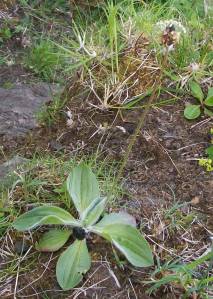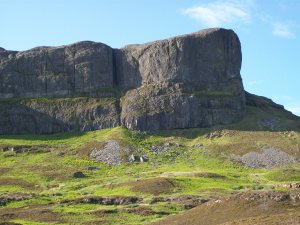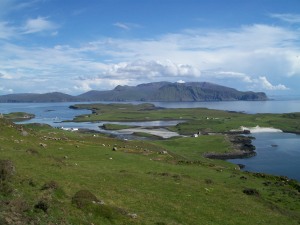I never made it to Muck this time as the weather was set to turn and I didn’t fancy heavy rain and strong winds in a one-man tent with all my gear. I shall go to Muck in a while.
I also failed to find Dactylorhiza viridis (Frog Orchid) at an old site on Eigg – as I did on Canna. I am wondering if it is flowering later this year (as suggested on the UK Botany Yahoo Group) as last year we found it at a different Eigg site on 12th June.
I appear to have made the first Canna record for Epilobium brunnescens (New Zealand Willowherb), the only major island in the vice-county from which it was missing (unless one counts Soay, which I guess one should as it is bigger than Muck). I also made only the second Canna record for Beta vulgaris subsp. maritima (Sea Beet), the previous one being an anonymously collected specimen from 1938 in the University of Glasgow herbarium. Perhaps irrelevantly, 1938 was the year that Canna was bought by John Lorne Campbell, who had met and married Margaret Fay Shaw, whilst they had both been collecting and recording Gaelic songs – he on Barra and she on South Uist. The 1938 specimen is most likely from Heslop Harrison’s expedition to Canna written up in Proc. Univ. Dur. Phil. Soc. 1939.
There may be more first or second records like this to report; I am only halfway through sorting out my Canna records.
Some plants on the northeastern coast of Canna left me wondering about the causes of large hairy forms of common plants. This for example is not Plantago media (Hoary Plantain) as one might at first think, but rather P. lanceolata (Ribwort Plantain):

and there are specimens at all intermediate levels from this to standard, lanceolate P. lanceolata. (Note the acute/apiculate leaves.) Also, there are large hairy specimens of Vicia sepium (Bush Vetch) and Ranunculus acris(Meadow Buttercup). I see this sort of thing elsewhere in the vice-county occasionally but there was an unusual concentration in this part of Canna. Don’t start me on Ranunculus acris var. villosus – as one moves up certain hills on Skye R. acris starts glabrous and gets longer and longer hairs until at a certain height one can call it var. villosus.
Something to do with exposure to extreme conditions, no doubt.



